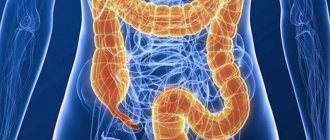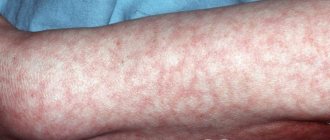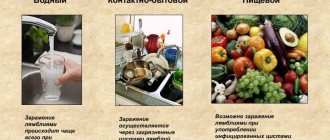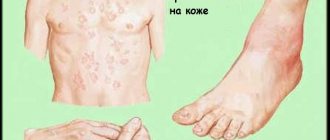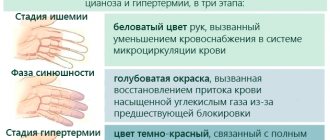What it is? Enteritis is a collective term for various pathological processes that cause inflammatory reactions in the intestinal walls. The mucous, muscular and serum membranes may be affected, but the mucous membrane of the small intestine is most often affected.
Inflammatory reactions provoke catarrhal or diphtheritic changes in the intestinal lining and can manifest themselves in various types of lesions - hyperemia and swelling of the mucous lining, hemorrhagic, purulent and ulcerative processes.
The causes of enteritis are due to bacterial, parasitic and helminthic infections of the intestines (worms), exposure to chemical and nutritional influences, and the destructive effects of bad habits and low-quality products.
The provoking factor of enteritis can be long-term use of medications, autoimmune and allergic processes, diseases and disorders in the enzymatic and gastrointestinal tract systems, genetically determined pathologies and much more.
Types of enteritis are classified:
- According to the nature of the causative factor - infectious, parasitic, toxic, medicinal, nutritional, postoperative, radiation, as a result of abnormal intestinal development, etc.
- According to the localization of inflammatory processes. Even with short-term inflammatory reactions in the small intestine, the process can cover various parts of the gastrointestinal tract, manifesting itself as duodenitis (inflammation of the membranes of the duodenum), jeunitis (inflammatory processes in the middle section of the small intestine - jejunum), or ileitis - inflammation in its lower section ( in the iliac fossa). But more often, inflammation covers the entire small intestine, combined with the development of gastritis (gastroenteritis), or colitis (enterocolitis), or both at the same time (gastroenterocolitis). In this case, they talk about the development of a total process.
- According to the nature of the lesion, enteritis with moderate or subtotal damage to the functional parts of the mucous layer and its tubular recesses (crypts) is distinguished, or pathology without such signs.
- According to the clinical course, the disease manifests itself as an acute, fleeting form, or protracted chronic enteritis in adult patients and children.
Enteritis can manifest itself as an independent form (primary, idiopathic), or as a secondary, symptomatic form accompanying background pathologies (mainly kidney and liver diseases).
What is enteritis
Enteritis is a disruption of the process of digestion of food by the intestines.
Normally, food passes through the esophagus into the intestines, where it is broken down into useful and harmful substances. In the small intestine, vitamins and molecules essential for human life are absorbed through the walls into the blood, from where they travel to cells throughout the body. Excess food and its undigested remains descend into the large intestine, where they are finally dissolved and excreted naturally. This process is also facilitated by the intestinal microflora itself, which assumes the presence of conditionally harmless microorganisms and enzymes that help the digestion process.
A reminder about the symptoms, treatment and prevention of enteritis (infectious) in adults
When the microflora environment changes, these microorganisms multiply, thereby worsening both the microflora and the process of food digestion throughout the intestine. Violation of the working functions of the small intestine is called enteritis.
Intestinal diseases are a whole group of pathologies associated with completely different factors or a combination of factors. Enteritis can develop against the background of a variety of chronic diseases, in combination with gastritis - inflammation of the stomach and colitis - of the large intestine. There are both harmless abortive forms that go away on their own in a day or two and do not require specific treatment other than a gentle diet, as well as chronic severe forms that are life-threatening or can significantly worsen its quality.
The general mechanism for the development of enteritis may be as follows:
- An irritating agent enters the body. This could be poor quality food, dirty water, parasite eggs, or poisonous compounds.
- Most harmful bacteria die during gastric digestion, so only a small part reaches the small intestine.
- Pathogenic microorganisms or toxic substances simultaneously enter the bloodstream and provoke local or general inflammation of the intestines.
- At the same time, the death of beneficial microflora occurs.
- The symptoms of enteritis increase as the body tries to cleanse itself of harmful substances or microbes.
After the main symptom complex passes, consequences are noted in the form of general weakness, dysbacteriosis, and bloating.
In the case of acute enteritis with a moderate course, treatment can be prescribed without diagnosis, exclusively symptomatic. Clinically healthy adults cope well with intestinal inflammation; this organ has a large margin of safety. Diagnosis and identification of the causes of the disease are required in severe acute or chronic forms.
Enteritis is an inflammatory disease of the mucous membrane of the small intestine, accompanied by dystrophic changes in this organ. The end result of enteritis is sclerosis and atrophy of the small intestine.
Enteritis is also a collective name for several diseases and pathological processes that differ primarily in the localization of the disease.
So, for example, inflammation of the duodenum, which is the beginning of the small intestine, is called duodenitis, inflammation of the jejunum is jeunitis, and inflammation of the ileum is ileitis. However, most often enteritis is combined with more local diseases - colitis and gastritis, which is why many patients are diagnosed with “enterocolitis” or “gastroenterocolitis”.
The main symptoms of enteritis are pain and rumbling in the abdomen, diarrhea, increased gas formation (flatulence), nausea.
The main causes of enteritis are intestinal infection, food and drug poisoning, disturbances in the normal state and balance of microflora in the organ (dysbacteriosis).
Development of enteritis
Before considering the issue of the development of enteritis, let’s look a little at human anatomy, after which it will be easier to understand what, where and where.
The intestine consists of 2 main parts - the small intestine and the large intestine, between which there is a mucous membrane that does not allow processed food to return back. The intestines follow immediately after the stomach.
The intestine begins with the small intestine, the large intestine follows it.
The function of the intestine is to digest food products entering the body, however, in the small intestine the main process of food digestion is carried out, including the absorption and transformation of nutrients, which then enter the bloodstream through the intestinal walls and spread throughout the body, while in The large intestine processes food completely, after which it leaves the body in the form of feces.
The intestinal microflora, which consists of several hundred different microorganisms (microbes), also takes part in the digestion of food. The largest populations in the intestinal microflora are bifidobacteria, lactobacilli, Escherichia coli, bacteroides, various fungi, protozoa and others.
Some scientists claim that the total weight of microorganisms in humans involved in the digestion of food is about 1.5 kg!
In addition to beneficial representatives of microflora, opportunistic microorganisms - staphylococci, streptococci, enterococci and others - are usually present in the intestines. These bacteria, in normal human health and condition, are controlled by the immune system and the basic intestinal microflora. But, if a malfunction occurs in the body due to various unfavorable conditions, the opportunistic infection begins to multiply sharply and suppress the beneficial microflora, which ultimately leads to the onset of the inflammatory process.
Very often, the pathological process affects the entire intestine, causing the development of enterocolitis or gastroenterocolitis (in combination with the stomach).
The trigger for a malfunction of the gastrointestinal tract can be stress, poisoning, disturbances in the blood supply to the intestines, taking antibiotics or hormonal drugs, etc., which we will learn in more detail in the section “causes of enteritis.”
Enteritis statistics
An interesting fact is that enteritis in dogs and cats occurs no less often, and in many cases more often than enteritis in humans, which indicates a fairly wide spread of this disease.
Moreover, enteritis in humans can in most cases only lead to dysfunction of the digestive system, but enteritis in dogs leads to the death of 5 to 50% of animals, the death rate of puppies is especially high - up to 90%.
Enteritis - ICD
ICD-10: A02-A09, K50-K55; ICD-9: 005, 008, 009, 555-558.
Symptoms
The clinical symptoms of acute and chronic enteritis differ significantly not only in duration, but also in the severity of metabolic disorders.
Signs of acute enteritis
As a rule, acute enteritis has an infectious etiology, so all the typical signs of an intestinal infection are noted:
- increased body temperature, sometimes up to 39 °C;
- general weakness, drowsiness, lack of appetite;
- painful nausea, episodes of repeated vomiting;
- diffuse abdominal pain or around the navel;
- spasmodic pain;
- diarrhea is watery, the volume of feces is significant, pathological impurities (blood, pus, mucus), as a rule, are absent;
- the development of symptoms of the disease is rapid and is associated with the consumption of poor quality food or violation of sanitary and hygienic rules.
We recommend reading:
Nonspecific ulcerative colitis: causes, symptoms and treatment methods
Acute enteritis, with timely consultation with a doctor and adequate treatment, ends safely. Complications are most likely to develop in young children (the first 3 years of life), patients with chronic pathology of the heart and endocrine system. Sometimes a protracted course of the disease and the formation of intestinal dysbiosis are possible.
Signs of chronic enteritis
Chronic enteritis is characterized by periods of deterioration of the patient's condition (exacerbation) and improvement (remission). The clinical picture is dominated not by inflammatory processes, but by dystrophic processes (atrophy of the intestinal mucosa), disturbances in the processes of absorption (malabsorption) and digestion (maldigestion), and deficiency of one or more enzymes.
Local signs (intestinal manifestations)
Clinical signs of chronic enteritis are appropriately divided into local and general. Among the local ones they note:
- bowel disorders in the form of frequent watery diarrhea;
- stool is liquid, yellow with areas of undigested muscle fibers or grayish with areas of fat;
- increase in the number of bowel movements 4-20 per day;
- almost constant flatulence, which intensifies in the afternoon, decreases after the passage of gas and bowel movements;
- pain in the abdomen of moderate intensity associated with the accumulation of gases, damage to nerve endings;
- intolerance to certain foods (sweet, dairy, flour), which is manifested by worsening clinical symptoms.
General signs (extraintestinal manifestations)
The change in the general condition of a patient with chronic enteritis is due to severe disturbances in the absorption and digestion of nutrients. Clinical symptoms depend on the predominant damage to one or another type of metabolism.
| Type of metabolism | How does it manifest itself? |
| Protein metabolism disorder |
|
| Lipid metabolism disorder |
|
| Carbohydrate metabolism disorder |
|
| Mineral metabolism disorder |
|
All patients with moderate and severe chronic enteritis have several similar signs:
- increasing weakness and fatigue;
- decreased appetite;
- irritability, memory impairment;
- deterioration of the condition of the skin, hair, nails.
Possible complications
Acute enteritis is quite rarely accompanied by the development of complications, this is due to the fact that the symptoms of the disease are often pronounced, so treatment begins very quickly. However, in some cases complications develop such as:
- acute form of vascular insufficiency;
- sepsis;
- perforation of the walls of the affected organ;
- hemorrhages.
In addition, complications include the transition of the acute form of enteritis to a chronic course.
With severe fluid loss, the consequences of the pathology may include acute vascular insufficiency. In severe forms of the disease, there is a risk of developing intestinal bleeding, necrotic changes or perforation of the affected organ.
With allergic or toxic pathology, there is a risk of damage to other organs. Thus, abnormal changes in the kidneys, liver, and heart may be observed.
Diagnostic methods
The doctor may suspect enteritis already during the examination and interview of the patient. During an objective examination of the patient, the following are observed:
- increase in abdominal size;
- pain on superficial and deep palpation, especially in the umbilical area;
- upon auscultation - intense noise of intestinal gases, sounds of iridescent liquid inside the intestinal loops.
We recommend reading:
Ileocecal valve (Bauhinian valve): concept, location, structure and functions
To confirm or refute the diagnosis of enteritis, special laboratory and, less often, instrumental studies are required. In the complex diagnosis of acute enteritis, the following are used:
- general clinical urine and blood tests (indirectly confirm the bacterial or viral etiology of the process);
- coprogram;
- microbiological (parasitological, bacteriological) examination of feces in order to determine the specific pathogen.
In the diagnosis of chronic enteritis, it is more important to assess the severity of metabolic disorders, as well as the motor-evacuation function of the intestine. For this we use:
- general clinical tests of blood and urine (anemia is detected; protein and microhematuria are detected in the urine);
- biochemical indicators (decrease in total protein and its fractions, hypoglycemia, decrease in lipid profile);
- coprogram (increased amount of feces, admixtures of undigested food, muscle fibers, fat and starch grains);
- various tests to assess absorption function (with D-xylose, lactose, potassium iodide, calcium chloride, albumin, labeled lipids, hydrogen test);
- tests to assess intestinal excretory function (Triboulet test, electropherogram, radionuclide technique);
- reactions to determine the digestive function of the intestine (alkaline phosphatase, enterokinase activity);
- X-ray examination with contrast agent;
- endoscopic examination of the condition of the mucosa followed by biopsy (if necessary).
Differential diagnosis is a difficult process, even for a doctor, of searching for common and distinctive points for enteritis of various etiologies and Crohn's disease, Whipple's disease, ulcerative colitis.
Diet for the acute stage of the disease
In order to avoid worsening the condition, at the acute stage of the disease the patient must follow a diet.
| Can | Absolutely not |
| Vegetable soups (from zucchini, broccoli, carrots, onions and pumpkin). | Alcoholic drinks |
| A small amount of white bread. | Flour |
| Buckwheat and wheat porridges. | Fatty dairy products. |
| Eggs | Products containing coarse fiber - legumes. |
| Low-fat chicken broth. | Fatty meat and fish. |
| Vegetables and fruits | Chocolate and caramelized products. |
The diet for chronic enteritis includes a lot of vegetables and fruits, boiled and baked foods without oil. It is advisable not to eat fatty fish and meats, which, although rich in healthy types of fat, make it difficult for a weak intestine to function.
Since chronic enteritis is accompanied by dysbacteriosis, nutrition should be as healthy as possible and include vegetables such as broccoli, onions, carrots, and pumpkin. Fruits rich in vitamins E and C should also be included in your daily nutrition plan - they help the body improve immune processes and control the growth of harmful bacteria.
When preparing a diet, the cause of inflammation, the nature and form of the disease, and the functionality of the intestine are taken into account. Gentle diets number 4, 4b, 4c are prescribed. The essence of such diets is the consumption of large amounts of protein foods and easily digestible fats of natural origin.
Fatty, sour, salty, spicy and bitter foods that can irritate the sensitive intestinal mucosa are excluded from the diet. It is recommended to eat soups, porridges cooked in water, sweet fruits, and steamed vegetables.
Etiology
The formation of acute enteritis is caused by the following reasons:
- diseases of a viral nature (rotavirus, enterovirus, adenovirus, etc.);
- poor nutrition – when the basis of a person’s diet is fatty and spicy foods;
- leading an unhealthy lifestyle, in particular addiction to alcoholic beverages;
- poisoning from low-quality food products;
- influence on the body of toxins and chemical elements;
- gastrointestinal ailments of infectious origin;
- infection with bacteria (Salmonella, Yersinia, Staphylococcus, Pseudomonas aeruginosa, Vibrio cholerae).
Often this disease is secondary and occurs against the background of diseases such as:
- inflammatory process in the pancreas;
- pathology of the liver or bile ducts;
- irritable bowel syndrome;
- autoimmune processes in which the body produces antibodies against its own cells;
- food allergic reactions, such as to citrus fruits, dairy products or eggs;
- irradiation of the body.
If a pathogenic organism enters the intestinal cavity, it begins to multiply and release toxins. This contributes to the formation of inflammation of the intestinal mucosa and cell death, which disrupts the absorption of water in the large intestine and nutrients in the small intestine.
Treatment of enteritis with folk remedies
Traditional medicine offers various effective methods for the treatment of chronic enteritis.
Take 3 parts of blueberry berries and leaves, 10 parts of chamomile and 4 parts of cinquefoil root. 2 tbsp. l. the collection is poured with half a liter of boiling water and placed on low heat for 10 minutes. Then leave for 30 minutes. Take 1/3 cup three times a day after meals.
Calendula
1 hour l. pour 200 ml of boiling water over calendula flowers and leave for an hour. Take 100 ml three times a day.
Picking with blackberries
Mix 1 tbsp. l. blackberry leaves, mint leaves and calendula flowers. 1 tbsp. l. collection, pour 200 ml of boiling water, leave for half an hour and filter. Take 1/2 cup three times a day before meals.
0.25 g of mumiyo is dissolved in 200 ml of water, taken 3 times a day, 200 ml 30 minutes before meals, for 3-4 courses for 10 days with 5-day breaks.
Aloe honey
Take 500 g of honey, 250 ml of 3-5 year old aloe juice, 500 ml of red wine. Mix the ingredients and place the composition in a dark place for 5 days. Take 1 tsp. 1 hour before meals, 1 time during the day. The duration of the course is 5 days. Afterwards they begin to take 1 tbsp. spoon 3 times a day 1 hour before meals for 3-7 weeks.
Chamomile. Add 3 tbsp. spoons of chamomile in 700 ml of boiling water, cover the product and let it brew for about an hour, then strain and add 100 g of natural honey to improve the taste. You need to drink this folk remedy for enteritis and other types of infectious gastrointestinal diseases 3 times, 30 minutes before meals. The course of therapy is up to 45 days, after which take a 14-day break and, if necessary, repeat the course.
Herbal medicine for chronic enteritis
Treatment of pathology using pharmacological agents is often combined with the use of medicinal plants. Among these herbal remedies:
with bactericidal and bacteriostatic effects: pomegranate and cranberry juice, blueberries, strawberries, raspberries, rose hips;
- with analgesic and antispasmodic effects: St. John's wort, chamomile, calendula, sage, yarrow;
- with anti-inflammatory, astringent and antidiarrheal effects: blueberries and bird cherry (fruits), oak (bark), alder (fruits), St. John's wort (herb), burnet (root and rhizome).
Herbal medicine normalizes intestinal functions , improves digestion, restores the “correct” intestinal microflora, eliminates dysbiosis, relieves inflammation from the intestinal mucosa, and has a beneficial effect on the patient’s nervous system.
Normalization of digestion and absorption
Chronic enteritis is often combined with disorders of the stomach and pancreas. That is why therapy for the disease provides supportive treatment for these organs that directly affect the digestive processes in the intestines.
- In case of secretory gastric insufficiency, the following are prescribed: gastric juice, Pepsidil, Betacyl, Limontar.
- In case of insufficient production of enzymes by the pancreas, the following are used: “Pancreatin”, “Solizim”, “Festal”, “Enzistal”, “Somilaza”, “Mezim Forte” and so on.
- When chronic enteritis is combined with cholecystitis and biliary dyskinesia, choleretic drugs are used: “Liobil”, “Allohol”, “Cholenzim” or “Oxafenamide”, “Berberine” (with increased diarrhea).
Traditional recipes for the treatment of enteritis
In case of its acute manifestation, these drugs are used at the stationary stage, and their main effect is aimed at the formation and maintenance of the natural environment in the small intestine and intestines. Also, folk recipes are helpers in stabilizing blood circulation and metabolic processes.
For toxic and allergic enteritis, it is imperative to use medications - natural homemade remedies can only aggravate the situation and lead to death.
Chamomile decoction
Chamomile has a very wide range of properties, including choleretic, antibacterial, antispasmodic and anti-inflammatory effects. A decoction of the flowers and leaves of this plant is used for intestinal and respiratory disorders, having a positive effect on the microflora.
The decoction is prepared as follows:
- Put 4 tbsp. l. inflorescences into a standard size glass.
- Pour boiling water over it.
- Leave for an hour.
- Take ⅓ glass 3 times a day for a course of no more than 7 days.
For enteritis in pregnant women, chamomile is recommended to be used with caution, as there is a risk of allergic reactions.
Cone tincture
Pine cone tincture is a rarely used but effective preventive remedy that improves blood circulation and the intestinal environment. Due to its properties, beneficial substances enter the human blood, promoting the active functioning of nerve cells.
Cooking method:
- Pour thoroughly washed pine cones (about 10 medium-sized pieces) into a container with a volume of at least 1 liter.
- Pour alcohol so that it covers all the cones.
- Leave for 2 weeks.
- Strain, add 5 ml of grape vinegar.
- Take 1 tsp. together with tea or chicory up to 3 times a day.
This tincture is harmless for those who do not have kidney or liver pathologies.
Plantain juice
Plantain juice has an anti-inflammatory and antiseptic effect, it contains useful substances such as enzymes, citric acid, vitamin C and organic acids. All these substances help normalize the intestinal microflora, allowing it to work in an active mode without the occurrence of pathologies.
Plantain is used in the form of juice:
- About 10 tbsp. l. Rinse and dry the crushed plantain leaves thoroughly.
- Squeeze them with gauze or squeeze them in a juicer.
- Strain and use 2 tbsp. l. in 20-30 minutes. before meals.
Plantain juice has the property of increasing the level of acidity in the intestines, which can lead to complications of diseases of internal organs. Therefore, it is necessary to discuss with your doctor the possibility of using this juice.
Iceland moss
Also, thanks to its vitamin composition, it regulates the balance of nutrients in the body, while simultaneously providing an antibacterial effect.
Icelandic moss is used in the form of a tincture:
- You need to take 50 g of this plant and rinse well using warm water.
- Pour the moss into a dark container and fill it with 60% alcohol.
- Infuse for 5-7 days.
- Use 10 drops if diarrhea or nausea occurs.
It is important to remember that this folk remedy cannot be used every day, but only when appropriate symptoms occur.
Calendula decoction
Calendula is one of the most popular medicinal plants in medical practice. Calendula contains various enzymes and organic substances aimed at improving the nutritional environment in the intestines, thereby improving the condition of the entire body.
Calendula decoction is also used as an antispasmodic, which regulates the frequency of contractions of the smooth muscles of the digestive organs.
The decoction is prepared as follows:
- 1 tbsp. l. Wash and dry calendula flowers.
- Pour 250 ml of boiling water.
- Leave for 45-60 minutes. in a dark place.
- Take 1 tbsp up to 5 times a day. l. before eating.
Since calendula has a bile-forming effect, it is not recommended to use it for acute gastritis and diseases of the gastric system.
Classification
In gastroenterology, several classifications of acute enteritis are used. Depending on the location of the disease, it can be:
- isolated;
- gastroenteritis - in cases of damage not only to the small intestine, but also to the stomach;
- enterocolitis – the large intestine is involved in the pathological process;
- gastroenterocolitis – when the entire intestine and stomach are affected.
Inflammation of intestinal tissue with enterocolitis
In addition, according to the degree of prevalence of the inflammatory process, there are:
- total or diffuse enteritis;
- jeunitis – the disease affects the jejunum;
- ileitis is inflammation of the small intestine only in the ileum.
Inflammation is not the only process that occurs with this disease. Thus, the disease has several varieties:
- acute catarrhal enteritis – swelling of the mucous and submucosal layer occurs;
- purulent – there is diffuse saturation of the wall of the affected organ with pus;
- necrotic – characterized by destructive changes in the lining of the small intestine. Erosions and ulcers may also form.
Depending on the etiological factors, acute enteritis is divided into:
- parasitic;
- infectious;
- food;
- postoperative;
- toxic.
There are several stages of this disease:
- light;
- moderate severity;
- severe, which can occur without complications or be characterized by their presence.
In addition, there are four more forms of enteritis, but only two of them can be diagnosed in humans:
- rotavirus – typical for children under three years of age, as well as for older people. The incubation period lasts from several hours to two days. Infection occurs through contaminated water or food, from a patient with a similar diagnosis, or through household appliances. Treatment consists of medications and diet therapy. Improvement occurs on the sixth day of therapy, but quarantine is extended to two weeks. After recovery, immunity against such a disease is formed;
- granulomatous.
Symptoms
Enteritis is characterized by the following symptoms:
- diarrhea – stool frequency varies from 5 to 15;
- increased gas formation;
- feeling of discomfort in the intestines;
- nausea and vomiting;
- interval pain in the area of the affected organ;
- stable body temperature;
- dry mouth;
- the appearance of plaque on the tongue, the coating has a characteristic white color;
- pallor;
- sunken eyeballs;
- deterioration of the current state of the body;
- fast fatiguability;
- lack of appetite;
- blood pressure reaches levels below the usual norm;
- increased sweating;
- intoxication.
If you notice any of the above symptoms, contact a specialist immediately. It is recommended to call an ambulance and explain to the arriving doctor the nature of the pain and deterioration of the condition. The doctor should palpate the area that is susceptible to infection and then order appropriate laboratory tests.
Please note: symptoms may vary or occur to different degrees. This is due to the individual characteristics of each organism.
Prevention
Prevention of intestinal inflammation consists of adequate heat treatment of food, compliance with personal hygiene rules and timely consultation with a doctor if symptoms of gastrointestinal dysfunction occur.
Enteritis is a common problem that can be treated. Comprehensive treatment of pathology helps to quickly stabilize the patient’s well-being. The main thing is to seek help in time.
Author: Denis Volynsky, doctor, especially for Zhkt.ru
Proper nutrition and diet
Rational nutrition is aimed at:
- Replenish fluids generously until vomiting and diarrhea resolve.
- Rehydrate with electrolyte drinks if fluid intake is low.
- Gradually move to easily digestible soft foods such as bananas, rice water or applesauce, and then gradually add cooked vegetables.
- Eliminate foods high in fiber and those that are difficult to digest.
- Avoiding fresh fruits and vegetables.
- Exclusion of dairy and fatty products, alcohol, seeds, nuts and tobacco.
- Focus on drinking water and fluids to prevent dehydration. The goal is to consume 3 liters (or twelve glasses) throughout the day. Intravenous fluids are prescribed in severe cases: if there is uncontrollable vomiting or diarrhea, severe exhaustion.
- Consume foods at room temperature, avoiding drinks and foods that are too hot or cold.
- Taking lactose-free supplements can help maintain your caloric intake without worsening your symptoms.
- Including baked chicken and fish, eggs, cooked vegetables, pasta and white bread in your subsequent diet.
Diet for enteritis is considered one of the necessary methods for successful treatment of inflammation.
Treatment of diarrhea with enteritis
Treatment of frequent bowel movements (diarrhea) is one of the important stages in achieving remission. To rid the patient of this unpleasant and dangerous symptom, the following actions are recommended:
- Diet correction: inclusion in the diet of foods that contain tannin helps to control bowel movements. Such products include: jelly, porridge, slimy soups, cocoa, tea, blueberries.
- Prescribing antibiotics (advisable if enteritis is caused by foreign microflora).
- Normalization of intestinal motility.
- Use of antidiarrheal drugs.
There are five types of such funds:
- inhibitors of the nervous parasympathetic system: adrenergic agonists (Ephedrine) and anticholinergics (belladonna extract, Atropine, Platifillin);
- drugs that affect intestinal motility (Codeine, Raesek, Loperamide, Nufenoxol);
- means for compacting stool (calcium carbonate, bismuth preparations);
- medications with an antisecretory effect (Berberine, nicotinic acid, Indomethacin, salicylic acid and antipsychotics);
- drugs that promote the secretion of bile with feces (aluminum hydroxide, Polyphepan, Cholestyramine).
In cases of predominance of hypermotility and intense pain, myotropic antispasmodics are prescribed: “ Halidor”, “No-shpa”, “Phenicaberan ”.
In order to reduce the rate of evacuation, the patient is prescribed Metacin, Platifillin or Atropine .
For constipation (rarely encountered with enteritis), it is recommended to take laxatives.
Metoclopramide (Cerucal) is taken as a stimulant of intestinal motor activity.
Correction of electrolyte and metabolic disturbances
Such disorders most often occur in patients with malabsorption syndrome (that is, grade 2–3 enteritis). Correction of disturbances in protein metabolism is carried out as follows:
- increasing the amount of protein in the diet, using white enpits;
- use of anabolic steroids (“Methylandrostenediol”, “Retabolil”, “Nerobol”);
- administration of protein nutrition through a tube drip into the stomach (“Aminazole”, “Casein”, “Alvezin”);
- administration of albumin, plasma and a mixture of amino acids (“Polyamine”, “Aminoplasmol”) intravenously by drip;
- administration of protein hydrolysates (“Aminotrof”, “Aminokrovin”, “Infusamine”) intravenously.
To restore fat metabolism:
- adjust the daily diet by adding foods rich in fatty acids (olive oil, margarine, sunflower oil);
- take Essentiale (intravenous administration);
- in case of significant weight loss and a decrease in the amount of phospholipids in the blood, Lipofundin is prescribed.
Causes
The main reasons for the development of pathology include the following:
- Consequences of past intestinal infections. These include dysentery, salmonellosis, and yersiniosis. The cause may also be infection with staphylococci or E. coli.
- Worm infestation. Opisthorchiasis, giardiasis, and cryptosporidiosis can lead to a chronic form of enteritis.
- Systematic drinking of alcohol.
- Overeating, eating a lot of spices, marinades, pickles. An unbalanced diet can also cause pathology.
- Adverse environmental factors, the influence of toxic substances and harmful radiation.
- Taking medications. These include antibiotics, hormonal agents, and non-steroidal anti-inflammatory drugs.
- Malignant formations.
- Chronic circulatory, respiratory or kidney failure.
- State of immunodeficiency.
- Surgical interventions on the stomach.
- Connective tissue pathologies. Provoking factors can be rheumatism and scleroderma.
- Chronic damage to the digestive organs - liver, stomach, pancreas. This category includes hepatitis, chronic pancreatitis or atrophic gastritis.
Development of enteritis in children, signs and symptoms
The genesis of the development of enteritis in children is primarily due to a decrease in the child’s immune defense against the background of infectious diseases, vitamin deficiency and intestinal dysbiosis, the provocative effects of cold drinks and foods rich in fiber. Often, the first manifestations of symptoms of enteritis in children are preceded by gastritis and recent infections.
- The main symptom of the development of enteritis in a child is diarrhea.
The stool may be yellow with many particles of undigested food and mucus included. Sometimes stool has a gray color with a characteristic clayey sheen and a fetid odor, which indicates a violation of the absorption of fats. If there is a fermentation process in the intestines, stool may have a foamy structure.
Additional signs include :
- Pain during bowel movements;
- Increased frequency of bowel movements (more than 15 times/day);
- Flatulence and intestinal rumbling;
- Cramping, dull, or bursting pain in the navel area;
- Intoxication symptoms in the form of vomiting and nausea;
- High temperatures.
Otherwise, the course of the disease in children is not much different from the manifestation in adults. Prescriptions of correct and adequate therapeutic procedures for the treatment of enteritis in children are carried out only by a doctor, after establishing the provocative factor and the severity of intestinal damage by inflammatory reactions.
General information
Enteritis is a whole group of inflammatory diseases of the mucous membrane of the small intestine.
Enteritis most often develops as a result of intestinal infection with bacteria, protozoan parasites, helminths, exposure to aggressive chemical agents, and nutritional disorders. Enteritis differs in the nature of its course into acute and chronic. In most cases, chronic enteritis is a consequence of untreated or insufficiently treated acute enteritis. In addition to factors directly irritating the intestinal wall, various functional disorders of the digestive organs and disorders of the enzymatic system, metabolic diseases and autoimmune conditions can play a role in the pathogenesis of inflammatory processes in the small intestine.
Enteritis
Preventive actions
To prevent the development of the disease, you must follow the recommendations:
- The basis of the diet should be healthy foods. The consumption of fats, smoked meats, pickles and spicy foods should be reduced.
- To live an active lifestyle. Thanks to this, it is possible to cope with stress.
- Don't eat toxic foods.
- Take antibacterial drugs, antidepressants and other medications only as prescribed by your doctor.
- To refuse from bad habits.
Chronic enteritis is a dangerous pathology that can cause negative consequences. To avoid this, you need to consult a doctor in a timely manner and follow his instructions.
If you liked the article, we invite you to write a review!


